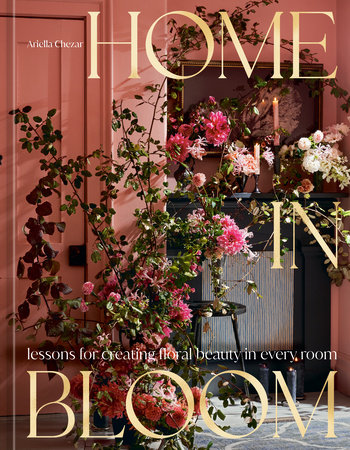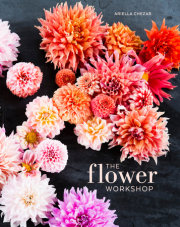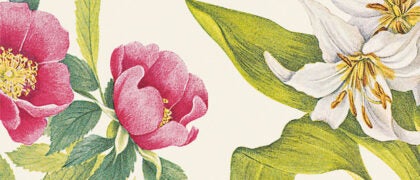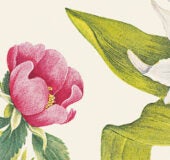With each chapter, I stray a little further into the meadow. I have always been fascinated by the magic of flowers. No matter the season, no matter the style of home, bring a bouquet of flowers into a room and the space is transformed. The life force inherent in a handful of blossoms or an abundantly flowering branch is the same: Both lift the space by adding color, scent, texture, and drama.
My goal has been to visit the homes of friends and acquaintances, mostly in the New England region where I live, and elevate the experience by adding flowers. Some spaces hold simple arrangements; in others, I take a deep dive into fantasy by exploring, for example, what a bathtub might look like surrounded by wild roses.I also wander further afield, visiting a New York City loft and a colonial villa in Merida, Mexico.
Whatever the location, I prefer to use flowers true to their season and environment. Tulips and dahlias fill the vases of a New England farmhouse, while bougainvilleas overflow in the Mexican villa. I take my inspiration from the colors of a room and also from its design: Is it modest and casual, welcoming friends around a country dining table? Or is it ornate and dramatic, calling for a more elaborate presentation?
In arranging my chapters, I’ve chosen certain rooms and situations that inspire the addition of flowers. “Welcome,” for example, shows the flowers that might grace an entrance and invite a visitor indoors. “Nourish” refers to the rooms that feed us, either for dining or for restoring our souls. “Celebrate” takes those spaces to another level, when a special event is worthy of a spectacular table setting or an arrangement that captures the drama of the moment. “Pause” addresses our more individual spaces: a bedroom side table boasting flowers that echo a comfortable pillow, a quiet corner with a perfect reading chair. The “Wilding” chapter breaks with more traditional designs and takes flower arranging on a more exotic turn, especially when photographed in the ruins of a Hudson River mansion.
Since I began my career as an eighteen-year-old selling Christmas wreaths on the sidewalks of New York, I have moved into and about the world of flowers—from New England to New York to California and back home again to this tiny village in the Berkshires.
I have followed the fashion and, at times, created my own. In New York I was assistant to a designer who favored tight, controlled flower arrangements that, as I look back now, seemed to strangle the very blossoms he was celebrating.
In San Francisco, I was astonished by jasmine vines cascading through empty lots; there were floral gifts on every corner. To the eyes of a girl from winter-tossed New England, this western coast was filled with abundance. When hired to create flower arrangements for an Oakland restaurant, I gathered armloads of blossoms, filling huge marble urns with cascading roses, arching spirea, twining clematis, and fruit-laden branches. This became my signature style. I wanted each arrangement to look fresh-picked from the garden, fruit tumbling across tablecloths, colors building tone upon tone, like mini-rainbows of a single hue.
Now, back home in the Berkshires, I walk my three rescue dogs—all Great Pyrenees in shades of beige and white—and stand astonished in autumn fields of golden grasses. Wild asters bloom along the border, viburnums are rusting from red to brown. I feel undone by nature.
I have always incorporated wild elements into my arrangements, be they weeds, branches, or vines rich with berries. However, in recent years, those elements have become more compelling than some cultivated flowers. Don’t get me wrong; a dahlia in full bloom still takes my breath away, as does a peony bursting in shades of coral and pink. But I don’t feel the same about hothouse roses or a Gerbera daisy.
If I were to propose my own theory of floral design, it would echo the views of Shane Connolly, floral designer for the coronation of King Charles III. “We need to see ourselves simply as servants and ambassadors of nature,” Shane wrote to his fellow designers. “You don’t have to abandon your own unique style. All you have to do is abandon the idea that you are more important than nature, and that you need somehow to subdue and control it.
That’s what I hope you’ll see in the flower arrangements collected in this book. I find myself relying more and more on wilder elements, not the always-magnificent flowers ordered from specialized nurseries. Those cultivated flowers remain the showstoppers in my work, but it’s the grasses and weeds I glean from local fields that give my arrangements a sense of place and a more natural style.
I learned this lesson most emphatically several years ago, when I joined Shane and two other outstanding floral designers—Emily Thompson and Christian Tortu—for a flower workshop in the south of France. We had gathered with our students at a three-star Michelin restaurant and inn near the Spanish border.
It was mid-July, and the blossoms we had ordered from the Paris flower market seemed too formal and unyielding when contrasted with the abundance of the countryside. We decided to put those buckets aside and take our class into the fields, where we foraged for plant material on the property, harvesting ferns and lichencovered branches, wild clematis, and grapes ripe on the vine. Next we headed for the local market, where we sourced fresh herbs, fruits, and vegetables. All of these went into copper vessels requisitioned from the celebrated kitchen, each pot brimming over with an abundance of weeds and wildflowers.
I still thrill to the memory of that weekend, and now that I live in the country I have access to a wilder style of floral design. In the pages that follow, you’ll see that even the most formal of my arrangements have something of the country tucked into their containers. I have even developed a fondness for the invasive wild rose that forms hedgerows on my farm, and the Queen Anne’s lace that populates summer fields. With each chapter, I stray just a little bit further into the meadow, until I arrive at a crumbling Hudson River manse that inspires a full-tilt fantasy of nature’s conquest.
I urge you to thumb through these pages and then walk in your own woods or fields or city park and find inspiration not in the perfect blossom but in the nature that surrounds you.
Copyright © 2024 by Ariella Chezar with Julie Michaels. All rights reserved. No part of this excerpt may be reproduced or reprinted without permission in writing from the publisher.















